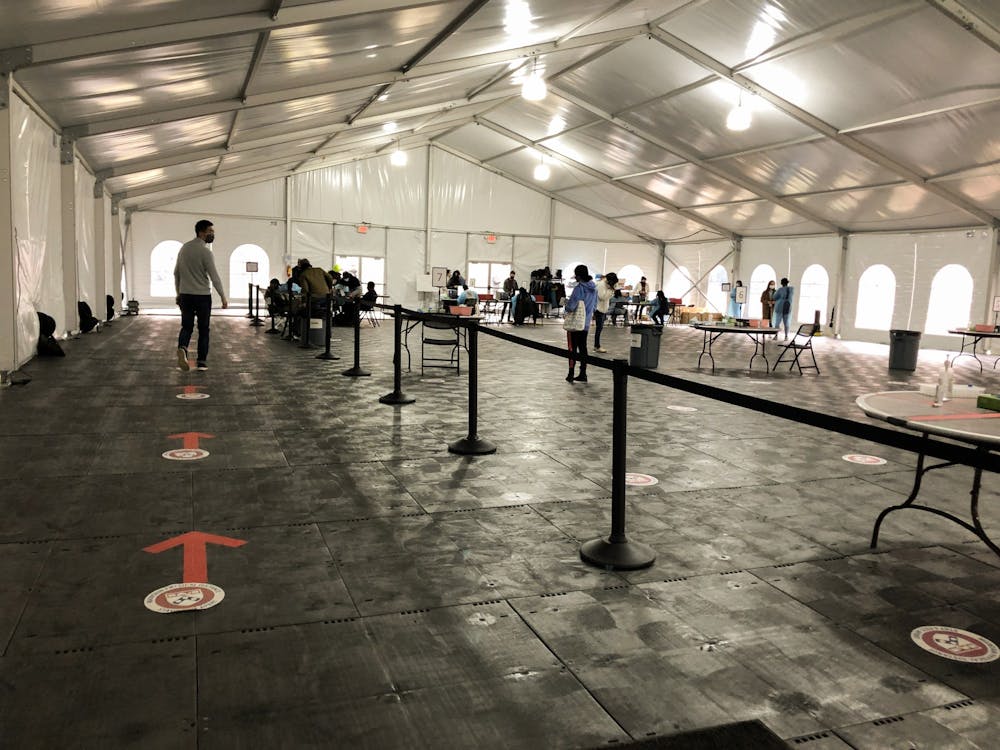Penn’s COVID-19 case count nearly doubled in the last week, reaching the highest number of positive tests in eight weeks.
A total of 273 community members tested positive for COVID-19 during the week from March 27 to April 4 — up 131 from the week before. Undergraduates comprised nearly 70% of new cases, with 187 total positive results. Graduate students made up only 42 of the new cases on campus.
Chief Wellness Officer Benoit Dubé told The Daily Pennsylvanian on March 31 that contact tracing efforts show that transmission remains heavily associated with social gatherings, such as formals, galas, and parties.
“Now that we are back to lower case counts, our contact tracing team can go back to doing its really important work of drilling down on the information that they are seeing from positives,” Dubé said.
Dubé added that data from the contact tracing team demonstrates that while the virus continues to evolve, its modes of transmission have remained the same throughout the pandemic.
“The dominant mode of transmission is when people attend large unmasked indoor gatherings when food and drink are being shared or consumed,” Dubé said. “The mutated virus does the same thing, and we’ve heard this story before.”
The campuswide positivity rate spiked, reaching 6.69%, up from 3.71% last week, continuing a seven-week increasing trend. This week marks the highest positivity rate since the week of Jan. 30 to Feb. 5. The undergraduate positivity rate saw the sharpest one-week increase in percentage and the second-highest number since the beginning of the semester at 12.77%, nearly doubling from 6.48% last week.
The rise in case count mirrors rising trends across the City of Philadelphia, which could potentially move the city into a stricter response level. Philadelphia is currently operating under the “All Clear” precautions tier, the lowest of four, which reversed the requirement for all individuals to wear a mask indoors on March 2.
“All Clear” requires that at least three of the four following conditions must be met before masking can end: citywide average new cases per day is fewer than 100, hospitalizations are under 50, positivity rate has dropped below 2%, and cases have not risen by more than 50% in the past 10 days.
The city reported on April 4 an average of 94 new reported cases each day, 48 hospitalizations, 3.1% positivity, and a case increase of more than 50% in the previous 10 days. If average cases increase by six or hospitalizations rise by two, the change would automatically trigger a change in response level to “Mask Precautions,” which would implement mask-wearing in public indoor spaces.
"Once masks come off, they might have to come back on again," Dubé told the DP on March 3. "We have to brace for that possibility as well."
The University recently moved to exempt fully vaccinated community members — who also received their booster shots — from weekly COVID-19 testing. Dubé added that this move means that the individuals most protected against the virus no longer have to participate in testing, which creates the environment for a higher positivity rate.
The increase in the campuswide positivity rate comes as community members get tested less, although the number of tests last week rose to 4,078 from 3,830 the previous week. During the fall semester, community members took over 10,000 tests through Penn Cares each week for 13 out of the 16 weeks between Aug. 29 and Dec. 18.
Dubé told the DP on March 17 that community members need to “unlearn bad habits” when it comes to understanding an increase in positivity rate. Since fewer community members are required to take COVID-19 tests, the denominator is a smaller number, so the positivity rate mathematically increases.
Community members who have either not yet uploaded their COVID-19 booster vaccine information or are not yet booster-eligible are still required to undergo screening testing twice each week. Students must upload their booster information into their Student Health Portal if they have not done so already.









